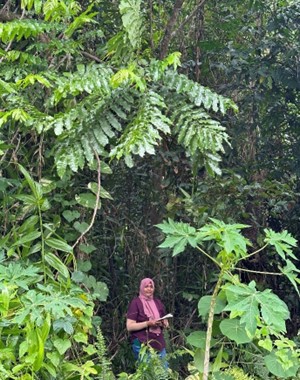Progress for taro vine in the Pacific
MWLR’s biological control programme against Devil’s ivy, also known more commonly in the Pacific as taro vine (Epipremnum pinnatum cv. ‘Aureum’), began in 2020 when the weed was chosen as a novel target for work under the Managing Invasive Species for Climate Change Adaptation in the Pacific (MISCCAP) project. With the conclusion of MISCCAP in 2024, efforts to find suitable biocontrol agents for use in the Pacific have continued under the Restoring Island Resilience project. In 2021 a feasibility study was conducted to assess if biocontrol would be a suitable option for managing taro vine in the Pacific. The study identified knowledge gaps relating to the identity of taro vine, its origins, and diversity across the Pacific. Addressing these uncertainties was critical if MWLR were to develop a sustainable, long-term solution for this highly invasive vine.

Image: tarovine covers a car in Niue.
“A major problem was the taxonomic uncertainty regarding the status of Epipremnum pinnatum cv. ‘Aureum’,” said Chris McGrannachan, who led the feasibility study. It was first described in 1880 as Pothos aureus from a plant growing in a nursery belonging to a Belgian botanist, Jean Jules Linden, in the Solomon Islands. However, the absence of wild plants in the Solomon Islands led botanists to search elsewhere to determine its native range. A specimen, initially described as Epipremnum mooreense, found growing in the island of Moorea in French Polynesia in 1899 proved to be morphologically identical to the specimen from the Solomon Islands. Subsequently, botanists assumed that Moorea was the origin of this species, which was renamed Epipremnum aureum in 1964. However, the vine is now considered to be an invasive introduced species in French Polynesia. A botanist, Albert Smith, noted in 1978 that the only difference between E. pinnatum and E. aureum is the former only ever has green leaves while the latter is mostly variegated. This, coupled with the fact that E. aureum rarely flowers, is unknown in the wild, and easily reproduces vegetatively, led Smith to conclude that it should instead be considered as a cultivar of E. pinnatum rather than a botanical species.
Molecular studies were needed to determine the true identity of taro vine, its diversity, and native range. Epipremnum plants were therefore sampled in Australia, parts of Asia, and across the Pacific at the same time as natural enemy surveys were undertaken in 2022 and 2023. Microsatellite analysis was used to compare genetic variation present in the two vines. “These analyses showed that taro vine (E. pinnatum cv. ‘Aureum’) and E. pinnatum have little genetic difference, supporting the view that taro vine is likely a cultivar of E. pinnatum,” concluded Caroline Mitchell, who led the molecular work. The genetic work also confirmed that populations of taro vine across the Pacific are identical. This meant that a highly damaging agent would be likely to provide effective control across the entire invaded range in the Pacific.
E. pinnatum is native to some Pacific Island countries in Melanesia, such as Fiji, Papua New Guinea, the Solomon Islands, and Vanuatu, and possibly on other Pacific islands, such as Samoa. However, it seems that E. pinnatum cv. ‘Aureum’ (henceforth called taro vine) has been extensively introduced and moved about for ornamental purposes, as it is predominantly found close to human habitation. It is still unknown where taro vine was first discovered, or if the cultivar even occurs in the wild. What we do know is that it is now a massively popular ornamental houseplant in many parts of the world for its colourful leaves, and perhaps because it is easy to grow and hard to kill.
The South Pacific islands provide the perfect environment for taro vine to thrive. It does well in wet, tropical and subtropical regions, is shade-, heat- and drought-tolerant, and grows in a range of soils. Taro vine is highly invasive in Niue and French Polynesia, and is showing invasive tendencies in places such as the Cook Islands, Hawaii, Marshall Islands, Samoa, Tonga, and Wallis and Futuna. In 2023 taro vine was ranked the third-highest priority weed for which natural enemies should be developed for the Pacific region by invasive species practitioners from across the Pacific. In Niue taro vine was scored the top priority weed during a prioritisation workshop in November last year. Anyone visiting or living in Niue can understand why: you don’t need to look far to see the impacts that taro vine is having. A quick drive from Hanan International Airport to the capital village, Alofi, will reveal entire coconut trees smothered by the vine, disused heritage homes completely covered, and entire stretches of forest smothered in a thick curtain of the green and yellow leaves.
The hard reality of invasive weeds such as taro vine for small island nations is that most lack the resources to keep these weeds under control, causing them to wreak havoc on the environment. “You have to rip it out and burn it, otherwise it grows back wherever you leave the cuttings. Sometimes a tree is too far gone, it’s got too much taro vine on it. The only option is to cut the whole tree down and burn it,” says Zack Smith, a local landscaper on Niue. Often, homeowners and growers on Niue are overwhelmed by the effort it takes to manage taro vine on their land. “People have to be aware about how they’re getting rid of the weed. If you’re just mowing over it, the fragments that the mower spits out will just grow into new plants. You need to know what you’re doing when you’re managing these weeds. It’s a process,” said Zack.
Using herbicides is problematic because the weed often smothers other plants, creating a risk of damage to the smothered plants underneath from herbicide spraying. Biocontrol offers the only possible sustainable, long-term option.
Fortunately, natural enemy surveys identified at least five potential biocontrol candidates for taro vine, including a stem-mining moth and beetle in Papua New Guinea, and sap-sucking lace bugs in Vanuatu and Fiji. It was noted that in some countries such as Fiji and Vanuatu, where E. pinnatum is native, taro vine is a well-behaved ornamental. In these places natural enemies of E. pinnatum appear to have moved across onto taro vine, preventing it from becoming invasive. This is also good news for the prospects of managing taro vine in places where it is problematic.
The first natural enemy to be studied is a lace bug, Holophygdon melanesica, from Fiji, which was imported into MWLR containment facilities in February last year. Life-cycle studies and host range testing were undertaken by Asma Bibi, a researcher from the Fijian Ministry of Agriculture, whose Master of Science degree, based at MWLR, involved investigating the lace bug as a potential biocontrol agent of taro vine. “My research confirmed that the lace bug only damages taro vine, E. pinnatum, and another close relative, Monstera deliciosa, making it a suitable agent for Pacific countries to consider,” said Asma.

Image: Asma Bibi in Niue surveying taro vine.
Work is now underway to introduce the lace bug to Niue later this year. Huggard Tongatule, of Niue’s Department of Environment, is excited about the release of a biocontrol agent against taro vine in Niue: “People here have been waiting for a long-term solution against taro vine for years. They can see how serious the problem is becoming, and they know we need to act quickly in order to get this under control,” Huggard said.
The introduction of a biocontrol agent against taro vine in Niue would represent a significant advance in the sustainable management of this invasive species. Successful control would contribute to the restoration of native vegetation, improve land management outcomes, and serve as a model for similar biocontrol efforts across the Pacific region. Given that more than one biocontrol agent is often needed to control such a highly invasive weed, work is underway to study the stem-boring moth in Papua New Guinea.
The Restoring Island Resilience project is funded by New Zealand’s Ministry of Foreign Affairs and Trade (NZMFAT) and administered by the Secretariat of the Pacific Regional Environment Programme as part of the Pacific Regional Invasive Species Management Support Service. The Managing Invasive Species for Climate Change Adaptation in the Pacific project was also funded by NZMFAT.
Key contact

